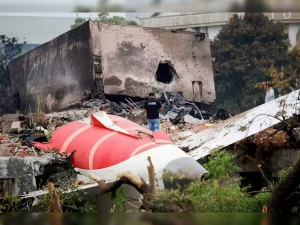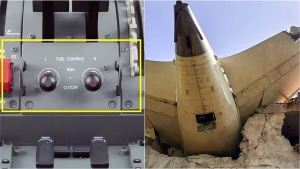Ahmedabad – The Air India Crash Preliminary Report released by India’s Aircraft Accident Investigation Bureau has unveiled disturbing details about the tragic June 12, 2025 incident that claimed 241 lives aboard the London-bound Boeing 787 Dreamliner. The report reveals that both fuel switches mysteriously moved to the cut-off position immediately after takeoff from Ahmedabad airport, effectively stopping fuel supply to the engines and creating a catastrophic situation that led to the aircraft crashing into a medical college.
The Air India Crash Preliminary Report includes chilling cockpit voice recordings that capture the confusion and panic in the aircraft’s final moments. According to the official documentation, one pilot was heard asking the other “why did he cut off,” to which the other pilot responded that he had not performed such an action. This exchange highlights the bewildering nature of the incident and suggests that neither pilot intentionally activated the fuel cut-off switches.
Devastating Impact and Casualty Details

The crash resulted in one of the most devastating aviation disasters in recent memory, with the Air India Crash Preliminary Report confirming that all 241 passengers and crew members aboard the aircraft perished in the tragedy. The impact was not limited to those on board, as an additional 19 people on the ground lost their lives, while 67 others sustained serious injuries when the aircraft collided with the medical college facility.
Among the victims were 52 British nationals, making this incident one of the deadliest plane crashes in terms of British fatalities. The Air India Crash Preliminary Report specifically mentions victims including sisters Dhir and Heer Baxi, who were returning to London after surprising their grandmother for her birthday celebration, and the Nanabawa family consisting of Akeel Nanabawa, his wife Hannaa Vorajee, and their four-year-old daughter Sara Nanabawa.
Families Demand Transparency and Accountability

The release of the Air India Crash Preliminary Report has not satisfied the grieving families who are calling for more comprehensive answers about what caused this catastrophic failure. Ishan Baxi, cousin of the deceased sisters, expressed his dissatisfaction with the current findings, stating that families are hoping for a more transparent and honest investigation that addresses possible mechanical flaws or protocol lapses.


The Air India Crash Preliminary Report represents only the first step in what families hope will be a thorough investigation. The Nanabawa family, through their representatives, described the current report as “the first stepping stone” while emphasizing their need for “honesty, transparency and an unwavering commitment to uncovering the full truth.” They stressed that understanding what happened is essential for finding closure and beginning the healing process.
Technical Analysis and Safety Protocols

The Air India Crash Preliminary Report reveals several important technical details about the incident. All crew members underwent breathalyzer tests upon arrival at Ahmedabad airport and were found to be “fit to operate the flight,” ruling out impairment as a contributing factor. The investigation also confirmed that no significant bird activity was detected near the flight path, eliminating bird strikes as a potential cause.
Fuel samples taken from the tanks used to refuel the aircraft were deemed “satisfactory” according to the Air India Crash Preliminary Report, suggesting that fuel quality was not a contributing factor to the accident. The aircraft began losing altitude before crossing the airport perimeter wall, indicating that the crisis developed rapidly after takeoff.
Ongoing Investigation and International Cooperation
The Air India Crash Preliminary Report indicates that investigators have identified “components of interest for further examinations,” suggesting that the investigation is far from complete. UK Transport Secretary Heidi Alexander expressed confidence in the investigation process and confirmed that British authorities are prepared to provide assistance to Indian investigators if requested.
The Air India Crash Preliminary Report investigation involves international cooperation, with the US National Transportation Safety Board also participating in the ongoing analysis. This collaborative approach ensures that the investigation benefits from global expertise in aviation safety and accident investigation procedures.
Legal and Industry Implications


Aviation lawyer Demetrius Danas, who is advising some affected families, described the findings in the Air India Crash Preliminary Report as “deeply concerning.” The legal implications of this incident are significant, particularly given the mysterious nature of the fuel switch activation and the international scope of the victims.
The Air India Crash Preliminary Report will likely influence future aviation safety protocols and may lead to enhanced monitoring systems for critical aircraft functions. The aviation industry is closely watching this investigation as it could result in new safety requirements for similar aircraft models.
Air India’s Response and Cooperation
Air India has maintained full cooperation with the investigation, with company representatives stating that they are “working closely with stakeholders, including regulators” and continue to “fully cooperate with the Aircraft Accident Investigation Bureau and other authorities as their investigation progresses.” The airline’s response to the Air India Crash Preliminary Report emphasizes their commitment to supporting the investigation process.
Looking Forward: The Path to Final Answers
While the Air India Crash Preliminary Report provides initial insights into this tragic incident, it clearly represents only the beginning of what will likely be a lengthy and complex investigation. The families of the victims, aviation safety experts, and the broader public await the final report that will hopefully provide definitive answers about what caused both fuel switches to move to the cut-off position and whether this was due to mechanical failure, human error, or other factors.
The ultimate goal of this investigation extends beyond determining causation – it aims to implement preventive measures that will ensure such a tragedy never occurs again, honoring the memory of all those who lost their lives in this devastating accident.

